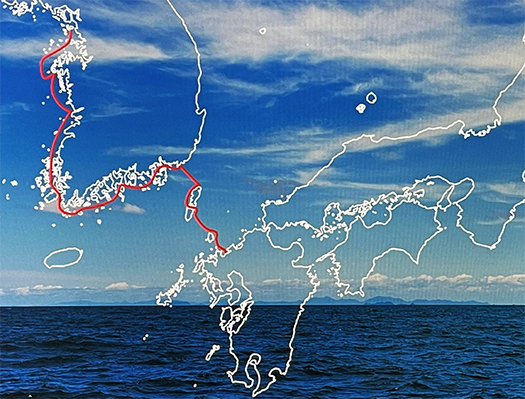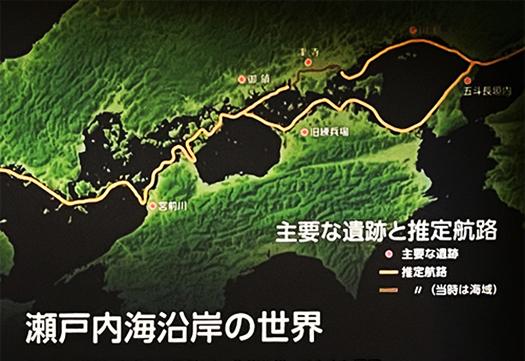


今回は古代日本と朝鮮半島を結ぶ重要な交通手段であった「櫓櫂船(ろかいせん)」について。
画像1枚目は国立歴史民俗博物館で展示されていたおおむね3世紀頃と思われる古代の移動の様子。
この画像からは魏志倭人伝が表現した倭国と朝鮮半島地域との交通状況が察せられる。ここで活躍していた移動手段が櫓櫂船だ。
櫓櫂船とは、読んで字のごとく艪(ろ)と櫂(かい)を使って人力でこぎ進む形式の船のこと。2枚目のパネル写真のように多人数で艪を櫂でこぎ進む。
人力の船というと現代では馴染みの無いもののように思えるが、実はそうでもない。
櫓櫂船にまつわるエピソードを持つ現代の有名人として、旧西鉄ライオンズの大投手・稲尾和久がいる。
「神さま・仏様・稲尾様」と讃えられた稲尾選手はこの櫓櫂で体力ととくに手首のパワーを付けたと言われる。
〜1937年に大分県別府市北浜に7人兄弟の末っ子に生まれる。父・久作は漁師で、
母・カメノは久作が釣った魚を売り歩き生計を立てていたが、行商中に産気づいて
和久を産んだという。漁師を継がせたいと考えていた父親の意向で1944年に
北国民小学校に入学すると稲尾は父に連れられて伝馬船に乗り、艪を仕込まれた。
稲尾は幼少時代について「薄い板一枚隔てて、下は海。いつ命を落とすか分からない
小舟に乗る毎日だったが、おかげでマウンドでも動じない度胸がついた」と語っている。
また、強靭な下半身はこの漁の手伝いによって培われた。〜(Wikipediaより引用)
上記の逸話からはなにか、古代の櫓櫂に通じるものを感じる。
とくに九州の海の男らしい、玄界灘の荒々しい波濤に挑む様子が匂い立ってくるようだ。
魏志倭人伝では伝聞として倭国への交通路が記述されているが、この玄界灘の波濤を超える船便は地域の生活伝統としてさらに古い時代からあったことだろう。
とくに半島側の出発地域は古代「任那」という倭国の勢力範囲もあった。
対馬から釜山までの最短距離49.5km、朝鮮半島は九州に比べ半分以下の近距離。
航海の様子のパネル写真は現代での実験航海のように思えるが、このように12人ほどでの櫓櫂で50km-100kmの外洋を渡ることがあっただろう。
そういった海の男の生き様伝統が九州北部にはあったことが想像できる。
古代、朝鮮半島の白村江(現在の錦江河口付近)で行われた日本・百済遺民の連合軍と唐・新羅連合軍との間の戦争である「白村江の戦い」で異国の海にて戦死した同胞もこうして渡海しただろう。
こうしてはるか昔の朝鮮半島と日本との海を越える交通事情について思いを馳せていると、過去に旅した韓国釜山の夜のことを思い出す。はるかな現代、韓国釜山のカラオケ店で海峡にまつわる演歌を歌いまくった(笑)。
その音色、リズム感がいかにも日本人の原点を想起させてくれた。
そういう海峡を越えての海の交通が瀬戸内海に入っていく。韓半島もそうだけれど、瀬戸内海もまた多島海そのもの。
さまざまな海流をたくみに利用しながら、難波津を目指した交通が日本人の生活文化のある基本旋律を構成したようにも思える。
やっぱり北島三郎的な海の男の演歌リズムが似合うのではないか。
韓半島から瀬戸内海という日本文化の主要なハイウェーそのものがかなり強い心情的基底を作ったというのは間違ってはいまい。
古い昭和人間には、まだこういう肉体的感覚が残っている(笑)。
English version⬇
Oar-boat over the Genkainada Sea and the Seto Inland Sea. 37,000 Years of Japanese Archipelago History-53
The culture of sea men in Kitakyushu, which nurtured the great pitcher Kazuhisa Inao. The base of the enka is the sentiment of the men who were responsible for the route from the Genkainada Sea to the Seto Inland Sea. …
In this issue, I would like to talk about “oar boats,” which were an important means of transportation between ancient Japan and the Korean Peninsula.
The first image shows the ancient movement of oared boats, which were exhibited at the National Museum of Japanese History and Culture, and are thought to date back to roughly the 3rd century.
This image shows the traffic situation between Japan and the Korean peninsula as described in the Wei-Shi-Wa-jin-Den. The means of transportation used here was the oared oar boat.
As shown in the second panel, a oar boat was rowed by a group of people using oars and oars.
Although the word “oar boat” may sound unfamiliar today, it is actually not so.
One modern-day celebrity with an episode related to oarboats is Kazuhisa Inao, the great pitcher for the Nishitetsu Lions.
Inao, who was praised as “God, Buddha, and Inao-sama,” is said to have used this oar to develop his physical strength and especially his wrist power.
〜Inao was born in 1937 in Kitahama, Beppu City, Oita Prefecture, the youngest of seven children. His father, Hisasaku, was a fisherman.
His father, Hisasaku, was a fisherman, and his mother, Kameno, earned her living by selling fish caught by Hisasaku.
She gave birth to Kazuhisa when she realized she had given birth while peddling. His father wanted him to take over as a fisherman, and in 1944, he enrolled at Kita Kumin Elementary School.
When he entered Kitakumin Elementary School in 1944, his father took him on a boat and trained him to use a Japanese oar (oroku).
Inao recalls his childhood, “A thin board separated us, and the sea was below us. You never know when you might lose your life.
I was in a small boat every day, but it gave me the courage not to be fazed when I was on the mound.
He also developed his strong lower body by helping with the fishing. ~ (quoted from Wikipedia)
The above anecdote reminds me of the oar oars of ancient times.
In particular, we can smell the way he was a man of the sea in Kyushu, challenging the wild waves of the Genkai Sea.
The Wei-Shi-Wa-jin Biography describes the transportation route to Japan as a hearsay, but the boat service over the waves of the Genkai Sea must have existed from an even older time as a regional lifestyle tradition.
In particular, the departure area on the peninsula side was also the area of influence of the ancient Japanese state of “Nina”.
The shortest distance from Tsushima to Pusan is 49.5 km, and the Korean peninsula is less than half the distance of Kyushu.
The panel photo of the voyage seems like an experimental voyage in modern times, but there must have been times like this when oarsmen with about a dozen oarsmen crossed the open sea at 50-100 km.
We can imagine that such a tradition of life of sea men existed in northern Kyushu.
In ancient times, the “Battle of the Paekchon River,” a war between the allied forces of Japan and Baekje and the allied forces of Tang and Silla in the Paekchon River (near the mouth of the present-day Geum River) on the Korean peninsula, would have been fought on foreign seas, and their compatriots would have crossed the sea in this way.
Thinking about the long-ago transportation between the Korean Peninsula and Japan, I was reminded of a night I spent in Busan, South Korea, in the past. In the far-off present day, I sang enka songs related to the straits at a karaoke bar in Pusan, Korea (laugh).
The tone and rhythm of the song reminded me of the origin of the Japanese people.
The sea traffic across such straits entered the Seto Inland Sea. Like the Korean Peninsula, the Seto Inland Sea is an archipelago itself.
It seems to me that the traffic that aimed at Naniwazu, while skillfully utilizing various ocean currents, constituted the basic melody of the Japanese way of life and culture.
The enka rhythm of a man of the sea, in the style of Saburo Kitajima, would be a good fit for this piece.
It is not wrong to say that the main highway of Japanese culture from the Korean peninsula to the Seto Inland Sea itself created a very strong emotional basis.
Old Showa people still have this kind of physical feeling (laughs).
Posted on 12月 29th, 2022 by 三木 奎吾
Filed under: 歴史探訪







コメントを投稿
「※誹謗中傷や、悪意のある書き込み、営利目的などのコメントを防ぐために、投稿された全てのコメントは一時的に保留されますのでご了承ください。」
You must be logged in to post a comment.